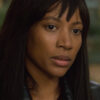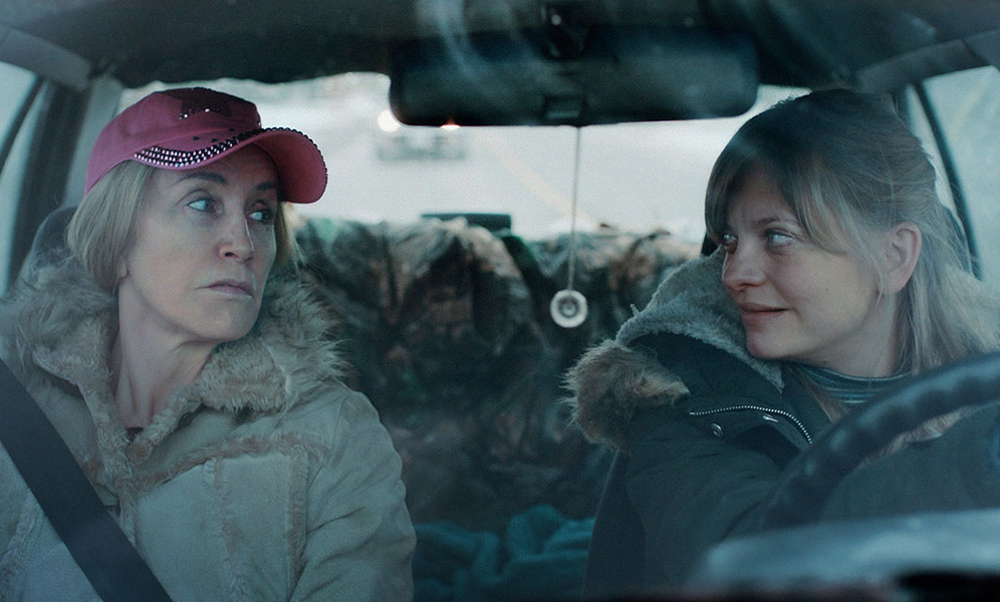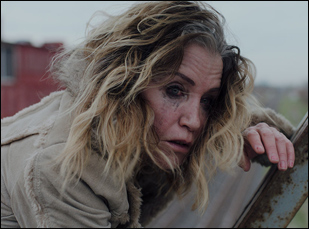Two months before starting production on “Tammy’s Always Dying,” Amy Jo Johnson began looking for the perfect bridge, scouring pictures online of every overpass in Ontario to find the central location for her second directorial effort.
“As soon as I saw that bridge, I hopped in my car and I drove straight to Hamilton and was like, ‘This is it,’” recalls Johnson, who was taken with the unique steel structure and the brick red factory wall that sat behind it. “The neighborhood that surrounds that bridge is very much a Tammy neighborhood, and I’m like we have to shoot the movie in Hamilton and we have to shoot it at this particular bridge.”
With its undulating metal, the bridge is indeed an fascinating bit of urban architecture, which is no doubt part of its appeal to Tammy (Felicity Huffman), a self-diagnosed manic depressive who envisions herself at least once a month jumping off of it, but it’s what Johnson is able to build on top of it that’s most enviable, delivering a tender and darkly comic drama about the tentative relationship that’s forged between Tammy and her estranged daughter Cathy (Anastasia Phillips) upon learning that the former has Stage Four cancer after long crying wolf. While Cathy has cared for Tammy in the past, dutifully climbing up the bridge any time she’s threatened to take her own life, Joanne Sarazen’s script puts the pair in a clever scenario with the necessity for the restless Tammy to actually stay in bed creating the space for the two to actually hear each other out as Cathy begins to let her resentment of her mother pass in order to start recalling the past that she missed when she wasn’t sober and Tammy finally has the patience to listen.
Johnson, who previously put it all on the line to make her feature debut “The Space Between,” launching a crowdsourcing campaign to prove the talent she had to work behind the camera after being a longtime presence in front of it on TV series such as “Felicity” and “Flashpoint,” handles risky material with ease in her second feature, bringing out the beauty in Tammy and Cathy’s complex relationship with raw and completely unvarnished performances from Huffman and Phillips and generously allowing for small character moments to give a sense of their lives and connections to each other. With the film set to debut this week at the Toronto Film Festival, the director spoke about taking a chance on making a film she hadn’t written herself, as well as how directing has made her rethink the work of acting and the important role music plays in her process.
I went to the Canadian Film Centre for their directors’ lab two years ago and it was there that I first heard a reading of the screenplay. Joanne Sarazen, who wrote it, was in the writers lab while I was there and I just fell in love with the story and the script. It was so funny and sad – I just loved it, so I asked Joanne if I could direct it and now we’re going to TIFF. So exciting!
You’ve originated all your previous films as a writer. Was it any different working from someone else’s script?
It was a whole different process for me. I chose the script because I did connect to it on a deeply core level, for personal reasons – my father’s a nonfunctioning alcoholic, a lot like Tammy and my mother actually passed away of cancer, so I could find my way in.
How did you find your wonderful leads for this?
First, we got Felicity Huffman, amazingly. She read [the script] and fell in love with it and we went [to meet] her to New York City and had a few back and forth between her, myself and Joanne [about how] the script would end and how it would all play out and as soon as Felicity came onboard, everything just started falling into place. Anastasia Phillips was the perfect casting [opposite Felicity] and both of them brought 150% to the part. They were wonderful to work with and they came on board so fully committed and prepared. It was a pretty amazing experience for myself.
Is there anything you bring to the process that you’d want from a director if you were in their shoes as actors?
Yeah, but every actor’s different, right? So for myself as an actress, I was always the type of actor who didn’t want to talk about it too much and didn’t want to tear things apart. I wanted to be very instinctual and not to get too heady. But there are actors who really like to talk it through and really do homework that I had never done before, so as a director, I’m having to figure out and learn how to open myself to other ways of the approach because that’s my job – is to help the actors to get to where they need to get to, by how they get there. So I have to be very open and use my brain a little bit differently than I normally do.
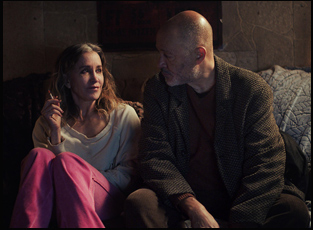
It was fascinating because with “The Space Between,” I cast very close friends, so this was the first project where I was working with actors I did not know previously. So as a director, I was just figuring out every one has their own process and I found it somewhat thrilling, intimidating and exciting at the same time. [Anastasia and Felicity had very different ways of approaching [the work], but yet they just worked so beautifully together. And the film’s intense, so I didn’t feel like I got to know Felicity until the very end of the film. We went out to dinner and it was like, “Oh…you’re Felicity! That lady on set was Tammy.” Like she was always Tammy. And Tammy is a tough cookie.
It’s clear she gave her all to the part. One of my favorite scenes in the film is when you see Tammy nuzzling up to her boyfriend Dougie (Clark Johnson) after working all day at the bar, almost like a puppy unsure of whether she’ll be accepted by him or not as they silently watch TV. What was it like to get that moment right?
I love that scene, and did you notice in the background Joan Rivers yakking away?
Yes!
It was my mission during post to make sure we got the rights to that clip because I just felt like it helped make the entire scene. with [Joan] just yakking away on the Home [Shopping] Network. That’s like from 30 years ago, but I love that scene a lot, especially because there is no talking and it’s just really is this beautiful, quiet moment that says so much about the relationship Tammy has with Dougie, which is so important in the film. But we just blocked it out and they did their thing. [laughs]
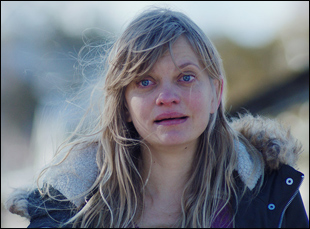
Music’s so important to me and when I write, I write to music, so [while] I wasn’t writing “Tammy,” definitely when I was shotlisting and piecing together how I wanted to shoot it, I was listening to music, in particular Cinjun Tate, who has a song in in the last moments of the movie and I had that song in mind for a long time. He’s a dear friend of mine and Bird York is also a friend of mine and she read the script and actually wrote that piece “Tight” that plays over the [end] credits, which was really cool. Then the opening song “Boomerang,” I was just driving to work to edit one day and I heard that and thought, “Such a great way to open a movie,” so all of it came together, and then Casey MQ came on to do the whole score, and we worked really closely together. I had never worked with a composer on score before, so that was a whole new experience this time around and I loved it. I thought he did a really beautiful job.
Was there anything you weren’t expecting that you wound up being really happy about?
Probably so much. That’s the thrill of shooting a movie, especially in 18 days, 100 miles per hour with a certain budget level. You just go in there and you get what you can get and then spend four or five months piecing it together and editing it together. So there were a lot of surprises and this was probably the biggest challenge of my entire career. Thank God that I did “The Space Between” [before this] because once you do something once, it gets a little less intimidating and I learned so much that definitely was very useful during this film. I’m very happy with how the whole thing turned out. I’m very proud of it and really grateful just being able to make the movie. The funding came from so many different sources in Canada – from Telefilm and CBC and Crave and Nabet [700-M Unifor], the union, and I don’t know if I could do that anywhere else, so I think I’m in the right place right now and I’m ready for the next one! [laughs]
“Tammy’s Always Dying” is now available on iTunes.


